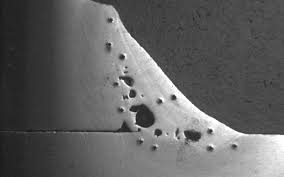Understanding What is Porosity in Welding: Reasons and Solutions
Understanding What is Porosity in Welding: Reasons and Solutions
Blog Article
Porosity in Welding: Identifying Common Issues and Implementing Finest Practices for Prevention
Porosity in welding is a prevalent issue that usually goes unnoticed up until it triggers considerable problems with the stability of welds. In this discussion, we will check out the essential aspects contributing to porosity formation, analyze its damaging impacts on weld performance, and review the finest practices that can be taken on to minimize porosity incident in welding procedures.
Usual Reasons For Porosity

One more frequent culprit behind porosity is the existence of impurities on the surface area of the base steel, such as oil, oil, or rust. When these pollutants are not efficiently gotten rid of before welding, they can evaporate and become caught in the weld, causing issues. Making use of dirty or damp filler products can introduce contaminations right into the weld, contributing to porosity issues. To alleviate these usual reasons of porosity, complete cleansing of base steels, proper securing gas selection, and adherence to optimal welding specifications are important practices in achieving high-quality, porosity-free welds.
Effect of Porosity on Weld Top Quality

The visibility of porosity in welding can significantly jeopardize the structural integrity and mechanical residential properties of welded joints. Porosity develops gaps within the weld steel, compromising its total strength and load-bearing ability. These voids serve as stress and anxiety focus factors, making the weld more at risk to fracturing and failure under used tons. In addition, porosity can lower the weld's resistance to corrosion and various other ecological elements, further lessening its durability and efficiency.
Among the key effects of porosity is a decrease in the weld's ductility and strength. Welds with high porosity levels often tend to show lower influence stamina and minimized ability to flaw plastically prior to fracturing. This can be find this especially worrying in applications where the bonded elements are subjected to dynamic or cyclic loading problems. Porosity can hinder the weld's capability to effectively send forces, leading to early weld failing and possible safety dangers in critical frameworks. What is Porosity.
Best Practices for Porosity Prevention
To boost the structural honesty and high quality of bonded joints, what details actions can be applied to minimize the occurrence of porosity throughout the welding process? Making use of the correct welding technique for the particular material being bonded, such as adjusting the welding angle and weapon setting, can better prevent porosity. Normal evaluation of welds and instant remediation of any kind of problems determined throughout the welding process are necessary techniques to avoid porosity and produce top notch welds.
Relevance of Appropriate Welding Methods
Implementing proper welding strategies is critical in guaranteeing the architectural stability and high quality of welded joints, developing this article upon the foundation of efficient porosity prevention steps. Too much warmth can lead to boosted porosity due to the entrapment of gases in the weld swimming pool. Furthermore, utilizing the proper welding parameters, such as voltage, current, and take a trip speed, is important for achieving audio welds with minimal porosity.
In addition, the choice of welding process, whether it be MIG, TIG, or stick welding, ought to align with the specific needs of the project to guarantee optimal results. Correct cleaning and preparation of the base steel, Read More Here as well as choosing the right filler material, are likewise necessary parts of efficient welding strategies. By adhering to these finest practices, welders can lessen the danger of porosity formation and produce top notch, structurally sound welds.

Evaluating and Quality Assurance Procedures
Testing treatments are essential to discover and avoid porosity in welding, guaranteeing the stamina and resilience of the last product. Non-destructive screening methods such as ultrasonic testing, radiographic testing, and visual inspection are generally utilized to recognize potential flaws like porosity.
Post-weld examinations, on the various other hand, evaluate the last weld for any flaws, including porosity, and verify that it meets specified standards. Carrying out an extensive top quality control plan that consists of detailed screening treatments and assessments is vital to decreasing porosity problems and guaranteeing the overall top quality of bonded joints.
Verdict
In final thought, porosity in welding can be an usual concern that influences the quality of welds. By identifying the common sources of porosity and applying finest methods for prevention, such as appropriate welding methods and screening steps, welders can ensure excellent quality and trusted welds. It is crucial to focus on prevention techniques to reduce the occurrence of porosity and preserve the honesty of bonded structures.
Report this page